
A section of the South Korean corvette “Cheonan” lifted out of the water; the ship was cut in half by the explosion
Israel did a false flag in March 26, 2010 that was blamed on North Korea . 46 of the 104 sailors aboard a South Korean corvette called “Cheonan” (pronounced “Choh-nahn”) died in this false flag when the ship exploded and sank.
A nuclear false flag attack on carrier strike group?

There is a high risk that Israel will perform another false flag that is similar to the Cheonan false flag. The US carrier strike group is currently heading to the waters near the North Korean coast (April 25th, 2017).
Israel may have attached nuclear explosives to one or more carriers while the carriers were docked in Singapore. This may have been the reason why the carrier was diverted to Singapore. Singapore is a nation that has close ties, including military ties, with Israel. There is a notably significant Mossad presence in Singapore. The U.S. media reported that while in Singapore, the USS Carl Vinson did exercises with the Australian Navy.

Is the USS Carl Vinson a floating nuclear bomb?
Other carriers are joining the USS Vinson. When the carriers are near North Korea, the nuclear explosives may be detonated, and the subsequent explosion blamed on a nuclear missile fired from a North Korean submarine. If this scenario does eventuate, it could be used as a pretext for the U.S. to attack North Korea with nuclear weapons, initiating a nuclear war between the US and North Korea.
North Korea may be able to fight a conventional war against the U.S. and survive but it won’t be able to fight one-on-one a nuclear war with the U.S. This might be a reason why the perpetrators may want a nuclear war to occur on the peninsula in preference to a conventional war.
Israel has to get the U.S. to attack North Korea before May 9th. This is the date of the South Korean elections. The frontrunner is Moon Jae-In. He is ahead of the runner up by 10 points. Moon Jae-In has stated he will sign a peace treaty with North Korea if he is elected. He has said “there is nothing more dangerous than having others decide our fate”.
After he is elected, there is very little chance that South Korea would agree to North Korea being attacked, and the president is likely to take actions, such as re-opening the Gaesong industrial complex, to cement ties with North Korea and further the cause of peaceful reunification with North Korea.
Read how North Korea was framed in the Malaysian Airport incident.

USS Carl Vinson
Can North Korean submarines fire ballistic missiles out of the water?
In the May 2015 news report, experts claim the video of an underwater submarine launch of a ballistic missile was modified.
Reasons:
- reflection of the exhaust flame did not match with the actual exhaust flame seen coming from the missile
- Photos are different. In one photo shown on state TV, a missile high in the sky leaves a trail of white smoke. But in other photos from state media, there is no white smoke. This could mean that these photos were of different missiles that had different propulsion systems.
“[It] seems sensible to assume that any North Korean SLBM [submarine-launched ballistic missile] capability is still a very long time in the future, if it will ever surface,” Markus Schiller and Robert Schmucker, of Schmucker Technologie, told Reuters.
James Winnefeld, a US navy admiral, said that Pyongyang is still “many years” from developing submarine-launched ballistic missiles.
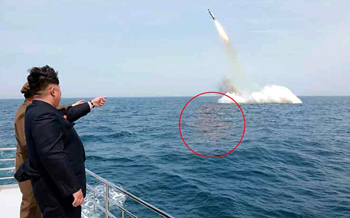
It published photographs of Kim Jong-un watching as missiles were apparently fired from a submarine beneath the ocean surface. However these may be faked photographs.
Adapted from The Telegraph
How the Cheonan attack was done
Israeli commandos infiltrated the security of Cheonan and attached explosives to the Cheonan ship , either while it was docked in South Korea, or when it was floating offshore. Mini-submarines could have been used to approach the ship underwater to attach explosives. At the appointed time, Israel detonated the explosive charges on the ship by remote control detonation from a mini-drone that flew above the ship at the moment of detonation. The drone remained in the area for at least half an hour after the detonation to monitor developments.
A torpedo was planted on the sea floor near the vicinity of the corvette as part of the preparation for the false flag. This rocket was later found during investigations. “No. 1” was written in what was thought to be North Korean language on the torpedo before it was dropped into the ocean.

The torpedo is unlikely to have been a North Korean one
Reasons:
- Schematics of the torpedo found on the sea bed do not match with North Korean torpedoes
- The torpedo was of German manufacture
- The writing on the torpedo was written over the rust on the torpedo
- The writing did not match North Korean language
- No torpedo was picked up by sonar prior to the explosion
- North Korea vehemently denied it was behind the attack and requested access to the evidence, which was denied
Schematics of discovered torpedo do not match schematics of North Korean torpedoes
The main evidence for the claim that the North Koreans are responsible is that the design of recovered torpedo matches the schematics of a previously captured North Korean torpedo. However, the evidence can be debunked by closely examining the details of the schematics.
The so-called evidence:
|
“The 5×5 bladed contra-rotating propellers, propulsion motor and a steering section perfectly match the schematics of the CHT-02D torpedo. |
There are 5 clear differences in the design of these weapons

1. “A” & “D” – In the diagram of the North Korean torpedo (schematic at top), you can see it has a smaller hub than the actual torpedo that was recovered.
2. * “B” – The actual shape of the propellers in the schematic of the North Korean torpedo is very different to the shape of the propellers in the recovered torpedo. You can see a notch in the diagram above that doesn’t exist in the propeller below. The overall shape of the blades are vastly different as well, with regards to both the front and the rear propeller sets.
Now, the last point proves they are not the same torpedo.
3. “C” – As you can plainly see, the stabilizers (or propulsion system?) in the schematic of a North Korean torpedo above are clearly shown IN FRONT of the separation plate. However, looking at the torpedo that was recovered, the same stabilizer (or propulsion system) is housed BEHIND the separation plate (separating the body and the tail section of the torpedo).
4. The shape of the fins in the schematic of the North Korean torpedo and the torpedo that was recovered from the ocean bed is different.
5. The axle of the North Korean torpedo is straight whereas the axle in the recovered torpedo is tapered.
Adapted from The Sinking of the Cheonan: We are being lied to
The torpedo was of German manufacture
On May 6th, 2010 a report conducted by South Korea and others came out that said the torpedo’s metal and explosive residue had a German origin.
The team of South Korean and foreign investigators found traces of explosives on several parts of the sunken ship. The investigators also discovered pieces of composite metal used in such torpedoes, according to the South Korea’s Yonhap news agency, quoting a senior government official.
… The metallic debris and chemical residue appear to be consistent with a type of torpedo made in Germany, indicating the North may have been trying to disguise its involvement by avoiding arms made by allies China and Russia, Yonhap quoted the official as saying. REUTERS News Agency
More from The Sinking of the Cheonan: We are being lied to.
The author of The Sinking of the Cheonan: We are being lied to states that the torpedo that was recovered from the ocean floor resembles the German-made DM2 A-3. This torpedo can be upgraded to the DM2 A-4 version.
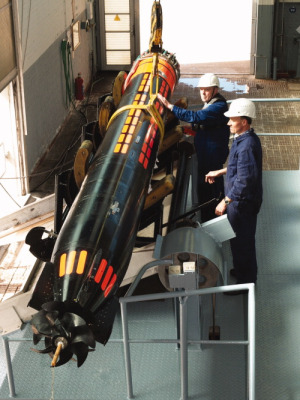
German-made torpedo DM2
In a paper I wrote yesterday I questioned whether or not the German-made DM2-A3 looked more like what was found.
“The DM2 A-3 version is also used by the Norwegian Ula class (German Type 210 subs) with an option for a later upgrade). The Italian Type 212 B submarines use the DM2 A-4 version. The Israeli Dolphin-class (German Type S-300) are also being equipped with the DM2 A-4 Torpedo.”
The German navy, Italian navy, Norwegian navy and Israeli navy all use the German-made DM2 A-3 or DM2 A-4 torpedo.
Berlin does not sell torpedoes to North Korea, however, Germany does maintain a close joint submarine and submarine weapons development program with Israel. Asia Times
Israel bought German-made torpedoes
Germany worked with Israel manufacture torpedoes according to this article written in 1995.
Electric Fuel Ltd., an Israeli electric battery manufacturer, said in late June it will help German defense contractor STN Atlas Elektronik GmbH develop a torpedo for the German navy.
Also, in this report, written in 2002, Germany had an armaments cooperation deal with Israel, in which many weapons and submarines were supplied to Israel. This cooperation in arms goes back to 1955/56.
German-Israeli armaments cooperation can be traced back to 1955/56 when Germany exported two coastal patrol boats to Israel. German-Israeli Arms Cooperation CAST: Eksport Vooruzheniy No. 6, Nov/Dec 2002
This cooperation includes the sale of German torpedoes to Israel. Israel chose to buy the DM 2A3 torpedo from Germany. This torpedo resembles the torpedo found on the sea bed in the Cheonan incident.
Even regarding “minor” purchases of subsystems, Israel has to resort either to US funds or to exchange-trade solutions. When it came to the selection of heavyweight torpedoes for the submarines, Israel at first wanted to buy US torpedoes Mk.48. When the US government declined, Israel chose the STN Atlas Elektronik Torpedo DM 2A3 export version Seahake. German-Israeli Arms Cooperation
Comparison of the German-made DM 2A-4 torpedo, recovered torpedo and schematics of North Korean torpedo
The shape of the propeller of the North Korean torpedo differs from the shape of the propeller of the German-made DM2 and the recovered rusty torpedo.
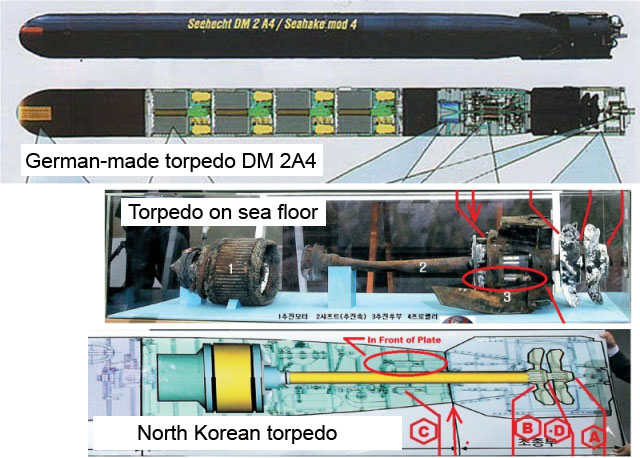
German-made DM 2A-4 at the top; recovered torpedo found on the sea floor; schematics of a North Korean torpedo at bottom.

There was writing on top of the rust on the torpedo

Readers of the website Willy Loman: We are being lied to about Cheonan are providing photographic evidence that the writing on the torpedo was written after the torpedo part was taken out of the water.
Mr. Shin was one of the investigators assigned to help with the official investigation of the sinking of the Cheonan. He is now being investigated for disagreeing with the “official results“.
Shin said Wednesday in a lecture he titled “Can we trust the Cheonan probe outcome?”
“The magnified photo of the evidence showed that the marking was written on the rusted surface,” he said. “If it were the North who marked it, the marking should have been written on a smooth surface.”
Below are the images of the writing of “No. 1” (1번) written on the torpedo part. You can clearly see in the progression of images that the marker ink was laid on top of some of the rust. You can also see where an area was cleaned prior to the writing.
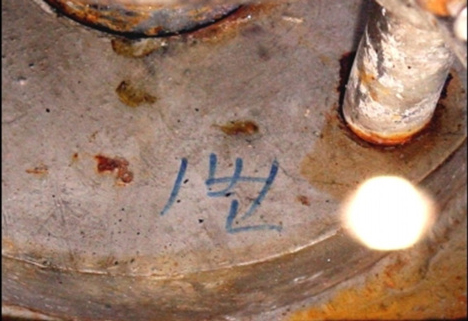


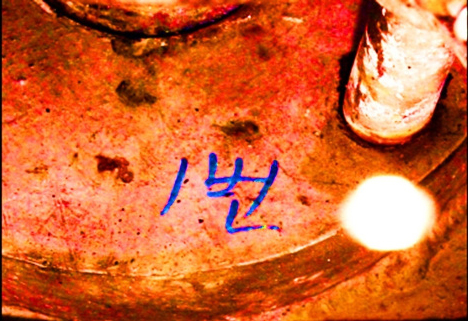

This is the website the following images came from. http://bbs1.agora.media.daum.net/gaia/do/debate/read?bbsId=D115&articleId=1004379 The website also shows how the build-up on the propeller blades could not have occurred in only a month and a half.
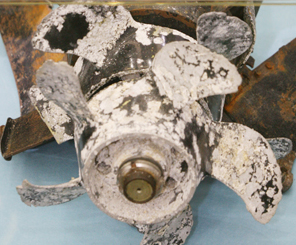
Evidence of cleaning in the area of the writing
There is evidence that there was an attempt to clean the area of rust. The area of suspected cleaning is outlined below.
The writing of “No. 1” is not North Korean language
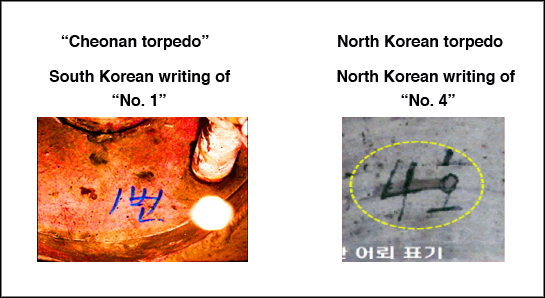
It was unlikely that the South Koreans set up North Korea in the Cheonan attack. The torpedo on the right was recovered by the South Koreans. They would be aware that North Koreans write “No.” differently to them.

This is the writing on the torpedo that was supposed to have hit Cheonan. It says “No. 1”.
According to Kim Myong Chol, who is referred to as the unofficial spokesman of the North Korean government, the writing of “No. 1” is consistent with South Korean language but not North Korean language. South Koreans write “No. 1” as “il bon” (1번), but North Koreans write it as “il ho” (1호).
The investigation team produced what it termed “conclusive evidence”: the eye-catching hand-written Korean markings “ilbon” or “No 1″ in English found on the propulsion section of the used torpedo allegedly recovered from the sea bed.
This turns out to be most inconclusive and counter-productive, calling into serious question the credibility of the findings. The use of “ilbon” in Korean script – not in Chinese characters – may look like North Korean writing, which is distinctly different from what is written in South Korea.
But native North Koreans use “ilho” for the English “No 1″. “Ilbon” is what South Koreans would use, although North Korean street addresses more often than often not do contain numerals like “ilbon“.
The discrepancy suggests that North Korea was framed. The perpetrator deliberately wrote “No. 1” in Hangeul (Korean characters) on top of the rust, not knowing that the North Korean language differs slightly from South Korean language.
Letter from South Korean Government confirms North Korean language different to the language on torpedo
The South Korean Government wrote a letter to the U.N. Security Council. In this letter are the photographs below. On the left is the CHT-02D, the torpedo that was recovered from the seabed in the Cheonan incident. “No. 1” is written as “1번” (“1 bon”). On the right is an torpedo that is alleged to be of North Korean origin that had been previously obtained by the South Korean Government. The writing of “No. 4” on the alleged North Korean torpedo is “4호” (“4 ho”).
South Korean letter: URL | DPRK S 2010 281 SKorea Letter and Cheonan Report

On the left is the torpedo found in the Cheonan attack. On the right is a torpedo that the South Korean Government claims is of North Korean make and that it had previously obtained. The language on the two torpedoes is different. Pictures are from a South Korean Government letter to the U.N. Security Council.
The alleged torpedo eluded sonar
In an article for Asia Times (see below), the author Myong Chol notes that the Chinese government did not accept the findings of the UN and stated that there were suspicions the Cheonan sinking was a false flag incident.
The main points that are put forward for this view, according to two American websites, are (Did an American Mine Sink South Korean Ship?):
To summarize the points:
- The site of the Cheonan sinking was relatively noiseless. It was near a naval base, on Baengnyeong Island (“Baeng-nyeong Island”), that conducts anti-submarine warfare, such as detecting the presence of enemy submarines. The conditions there were perfect for picking up the slightest agitation, such as the firing of a torpedo or the movements of a nearby submarine.
- A flotilla of ships, led by an Aegis warship, was in South Korean waters at the time of the sinking.
- The Cheonan sinking occurred in the aftermath of the March 11-18 Foal Eagle Exercise, which included anti-submarine maneuvers by a joint U.S.-South Korean squadron of five missile ships.
- One of the ships in the flotilla was USNS Savor which was a mine-laying ship. It was located close to the naval base on Baengnyeong Island.
- Berlin does not sell torpedoes to North Korea, however, Germany does maintain a close joint submarine and submarine weapons development program with Israel.”
From Asia Times:
Fact One: Baengnyeong Island hosts a Secret Joint US-South Korean Naval Base for anti-submarine warfare (ASW) operations. Absent civilian traffic around it, “the noiseless conditions are near-perfect for picking up the slightest agitation, for example from a torpedo and any submarine that might fire it”. The joint US-South Korean naval base is staffed by American and South Korean naval special operation force personnel.
Fact Two: An Aegis ship-led US flotilla was operating in the South Korean waters in question at the time of the sinking of the South Korean warship.
Fact Three: The US flotilla included a mine-laying USNS Savor, stationed close to Baengnyeong Island.
Contrary to the belief that the ship was under the command of the Seventh Fleet, the NAM story noted that the USNS Salvor was “controlled by the innocuous-sounding Military Sealift Command and is closely connected with the Office of Naval Intelligence since their duties include secret operations such as retrieving weapons from sunken foreign ships, scouting harbor channels and laying mines, as when the Salvor trained Royal Thai Marine divers in mine-laying in the Gulf of Thailand in 2006, for example.”
Fact Four: The US Navy SEALs “maintains a sampling of European torpedoes for sake of plausible deniability for false-flag attacks. Also, Berlin does not sell torpedoes to North Korea, however, Germany does maintain a close joint submarine and submarine weapons development program with Israel.”

Baengnyeong Island. The Cheonan was sunk 5 km from the naval base.
China stated that there were strong grounds to suspect North Korea was innocent
In an article in New America Media, it was reported that:
In the recent U.S.-China strategic talks in Shanghai and Beijing, the Chinese side dismissed the official scenario presented by the Americans and their South Korean allies as not credible. This conclusion was based on an independent technical assessment by the Chinese military, according to a Beijing-based military affairs consultant to the People Liberation Army.
__________________________________________________
The initial assessment was that a North Korean attack was unlikely
Probable reasons for this assessment were that:
- No suspicious activities or movements detected before and after the ship sank.
- North Korean warship’s infiltration would have been easily revealed as site of incident was only 10-12 kilometers from the Northern Limit Line (de facto sea border between North Korea and South Korea) where vigilance is high and monitoring and surveillance activities are carried out
- Waters where the corvette sank is shallow, which would make the operation of a North Korean war ship difficult
Some features of the incident
– all electricity was cut off at the time of the explosion, causing communications to shut down except cell phone operation
– internal shock can’t be ruled out
– the ship was split in half by the explosion and the back half immediately sank
– the explosion and sinking of back half happened in two minutes
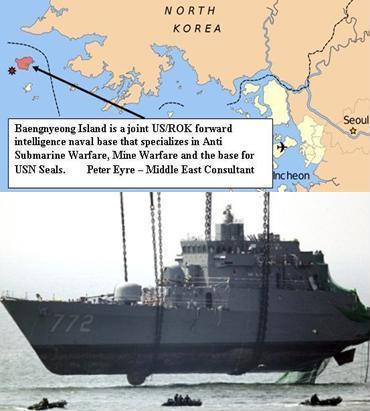
Baengnyeong Island (“Baeng-nyong” Island) is a joint US/ROK forward intelligence naval base that specializes in anti-submarine warfare, mine warfare and is the base for USN Seals. –Peter Eyre – Middle East Consultant
From Korea Herald (March 27, 2010):
|
[Commander] Choi Won-il, who led the sunken ship, said the explosion appears to have been caused by “internal or external shocks.” “The exact cause of the explosion can be verified after the ship is salvaged and a thorough investigation is carried out,” he said. “The ship was broken into two parts and the rear of the ship abruptly sank… During an emergency session of the National Assembly’s defense committee, Lee Gi-sik, chief of the Defense Ministry’s intelligence operations, said that captain Choi reported the situation to the chief of naval operations with his mobile phone right before the ship sank. “All electricity was cut off at the time so the captain reported the situation with his cell phone,” Lee said. “There was a big detonation and the engine stopped and the electricity was cut off. I went up to the deck and couldn’t see the stern of the ship there. All happened within two minutes,” the captain was quoted as saying by Rep. Kim Hak-song of the ruling Grand National Party who chairs the committee. Some reports earlier said that the government presumes that the possibility of North Korea’s involvement in the incident is low. According to them, as the Northern Limit Line, which serves as a de facto sea border, is about 10-12 kilometers away from where the ship sank, a North Korean warship’s infiltration would have been easily revealed. They added that the waters where the ship sank were relatively shallow, meaning the operation of a North Korean warship would be difficult. The U.S. forces in Korea are also said to presume that the possibility of North Korea’s involvement is low as there were no suspicious activities or movements detected before and after the ship sank. “The exact cause of the incident has yet to be verified, but if we sum up investigations conducted by related ministries, the North does not appear to be involved in the incident,” a government source was quoted by Yonhap News as saying. |
_______________________________________________
Radar picked up significant activity – UAV?
The radar of one of the ships in the Joint Strike Command picked up some activity in the air 27 minutes after the explosion, and the ship fired on the “radar contact”. This was said to have been birds, but others said this was unlikely as “the Navy’s patrol ships are equipped with sophisticated radar devices.”

9:30 pm Friday: Blast occurred ; 9:57 pm: Warning shot at unidentified object
The possibility that a UAV was deployed in the vicinity of the Cheonan around the time of the attack in order to:
- Detonate the explosive on the ship by remote control
- Monitor the ship and activities after the explosion
Drones could have been used to detonate the device as probably happened in the 9/11 attacks
Drones could have been employed thus in the same way they are presumed to have been used in the 9/11 attacks on the World Trade Center.

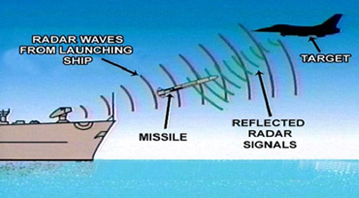
In the 9/11 attacks on the World Trade Center, it is theorized that helicopter drones could have been used to detonate the explosive devices within the buildings by remote control (see “Plane Missile”). In the same way, UAVs may have controlled the detonation of the explosives that had been pre-planted in or on the Cheonan. Right: The missile would be a limpet mine attached to the ship. The firing would be done with radio remote control.
There was much helicopter activity around the World Trade Center Twin Towers during the attacks. Helicopters were flying near the Twin Towers at the times of detonations and shortly prior to the detonations. If they were drones, they could have been used to effect the remote detonation of the explosives in the Twin Towers. Signals could have been relayed from a ground control station to the drone helicopters, and then the signal to fire could have been sent from the drones to the explosives within the buildings.
From Korea Times:
|
Another lingering question is why a nearby patrol ship fired a warning shot toward the North soon after the tragic sinking. In this regard, the JSC said one of their ships had fired on a radar contact that turned out to be a flock of birds. Some military experts, however, point out that the chance of firing warning shots at a flock of birds is unlikely, as the Navy’s patrol ships are equipped with sophisticated radar devices. |
Unmanned aerial vehicles
From a video by Israeli drone company Malat:
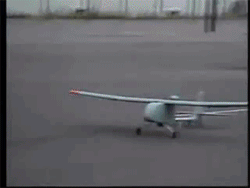

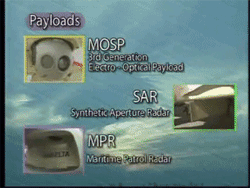
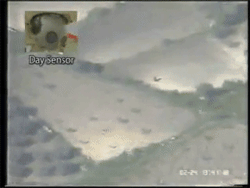


Future planned drone from Lockheed Martin (2007)
VIDEO: Lockheed Cormorant unmanned aircraft (in development, video’s date is 2007) Youtube
#limpet
_______________________________________________
How the attack could have happened (speculation)
Mini-submarines (“human torpedoes”)
An Israeli submarine was sent to the South Korean region. Israel is known to possess Dolphin class submarines. It purchased its first German-made Dolphin class submarine in 1999. A mini submarine, either a one-person or two-person submarine, was sent to the corvette, which was floating about 5 km off the coast off South Korea.

The mini submarine is often cigar-shaped and is often called a “human torpedo” because of its torpedo-like shape. (Image from Maiale-Pig-Human-Torpedo)
Limpet mine
The mini submarine was used to transport an explosive, possibly an attachable explosive, like a limpet mine.

Image of a limpet mine attached to a ship’s hull. (Image taken from video)
Once the corvette was reached, the explosive was attached to the under-surface of the corvette.
Too small to be picked up by radar
The mini submarine would be too small to be picked up by sonar. It is not known if the South Korean ship had been equipped with a hydrophone.
Schematics of North Korean torpedoes
Israelis knew the schematics of North Korean torpedoes because North Korean ships had been intercepted in the past carrying torpedoes, which were probably headed for an ally nation of North Korea, as part of a sale of arms. Printed schematics of North Korean submarines could have been obtained in this way.
Additionally, South Korea had access to the schematics as well as they had captured a North Korean torpedo in the past, as revealed in the letter South Korean authorities sent to the U.N. about the Cheonan incident. As it can be presumed that South Korean intelligence is shared with the US, it can also be assumed that anything that the US has access to, the Israeli intelligence service has the same access to. A torpedo of German manufacture was used for this operation as it was a close match to the schematics of a North Korean torpedo.
“No. 1” was written to make it look like a North Korean torpedo
On a separate trip, the mini-submarine dropped off a German-made torpedo with “No. 1” written on it (but the language did not match North Korean language), on top of the rust, in the vicinity of the corvette, where the torpedo sank to the ocean floor.
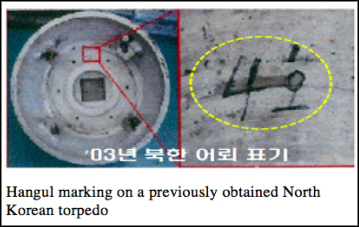
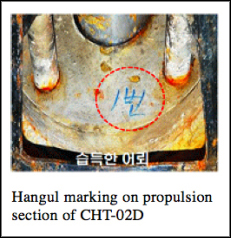
Note the words “No. 4” written in Hangeul (Korean script). The words “No. 1” looks as if it was written to emulate the writing on the previously obtained North Korean torpedo. However, if it was, the translation into North Korean language is wrong.
Mini-drone
After the explosive device had been attached to the ship and the rusty torpedo had been placed on the seafloor, when it came time for the device’s detonation, a UAV was sent to the ship, that was floating 5 km from the island of Baengnyeong to do the task. Bigger than a seagull but much smaller than a small ordinary plane, the unmanned aircraft was flown within the vicinity of the ship, and a radio signal was sent to it to execute the firing of the explosive device.
The small UAV may have been picked up by radar and mistaken for a flock of birds.


Heron UAV is made by Israel’s Malat Industries. This UAV was involved in a border incident in which North Korea claimed that South Korea flew UAVs across the border into North Korea. South Korea denied this.
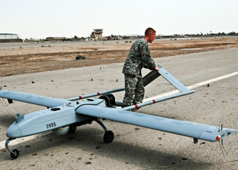
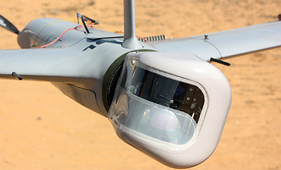
Left: Heron mini-UAV Right: Orbiter mini-drone.
Operation Trojan – a coastal operation in Libya involving “pigs”
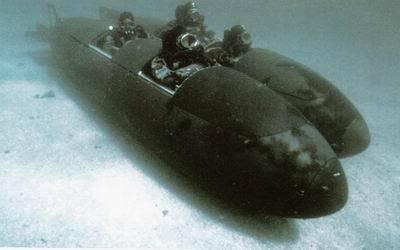
The cigar-shaped mini-subs were nicknamed “pigs”.
In 1986, the Israelis did a covert operation called “Operation Trojan”. This operation involved the use of two-man submarines called “pigs”. These submarines were cigar-shaped and were used to transport the “trojan” (a communications device), a cylinder that was six-feet long and seven-inches in diameter.
The following is an extract from Victor Ostrovsky’s “The Other Side of Deception“, a book about the Mossad.
[In 1986] The commandos were charged with the task of planting the Trojan device in Tripoli, Libya.
On the night of February 17-18, two Israeli missile boats, the SAAR 4-class Moledet, armed with Harpoon and Gabriel surface-to-surface missiles, among other weaponry, and the Geula, a Hohit-class missile boat with a helicopter pad and regular SAAR 4-class armament, conducted what seemed like a routine patrol of the Mediterranean, heading for the Sicilian channel and passing just outside the territorial waters of Libya. Just north of Tripoli, the warships, which were visible to radar both in Tripoli and on the Italian island of Lampedusa, slowed down to about four knots – just long enough to allow a team of twelve naval commandos in four wet submarines nicknamed “pigs” and two low-profiled speedboats called “birds” to disembark. The pigs could carry two commandos each and all their fighting gear. The birds, equipped with an MG 7.62-caliber machine gun mounted over the bow and an array of antitank shoulder-carried missiles, could facilitate six commandos each, while towing the empty pigs. The birds brought the pigs as close to the shore as possible, thus cutting down the distance the pigs would have to travel on their own. (The pigs were submersible and silent but relatively slow.)
Two miles off the Libyan coast, the lights of Tripoli could be seen glistening in the southeast. Eight commandos slipped quietly into the pigs and headed for shore. The birds stayed behind at the rendezvous point, ready to take action should the situation arise. Once they reached the beach, the commandos left their cigar-like transporters submerged in the shallow water and headed inland, carrying a dark green Trojan cylinder six feet long and seven inches in diameter. It took two men to carry it.
A gray van was parked on the side of the road about one hundred feet from the water, on the coastal highway leading from Sabratah to Tripoli and on to Benghazi. There was hardly any traffic at that time of night. The driver of the van seemed to be repairing a flat tire. He stopped working as the team approached and opened the back doors of the van. He was a Mossad combatant. Without a word said, four of the men entered the van and headed for the city. The other four returned to the water, where they took a defensive position by the submerged pigs. Their job was to hold this position to ensure an escape route for the team now headed for the city.
______________________________________________
UN Security Council statement does not identify the attacker and Russia does not concur with South Korean and U.S.
Peter Eyre – 5/4/2013 Galactic Connection
|
Quote: The ROKS Cheonan sinking occurred on 26 March 2010, when the Cheonan, a Republic of Korea Navy ship carrying 104 personnel, sank off the country’s west coast near Baengnyeong Island in the Yellow Sea, killing 46 seamen. A South Korean-led official investigation carried out by a team of international experts from South Korea, the United States, the United Kingdom, Canada, Australia, and Sweden presented a summary of its investigation on 20 May 2010, concluding that the warship had been sunk by a North Korean torpedo fired by a midget submarine. North Korea denied that it was responsible for the sinking. North Korea’s further offer to aid an open investigation was disregarded The Peoples Republic of China dismissed the official scenario presented by South Korea and the United States as not credible. An investigation by the Russian Navy also did not concur with the report. The United Nations Security Council made a Presidential Statement condemning the attack but without identifying the attacker. |
___________________________________________________
Letter from the South Korean Government to the UN Security Council:
URL: http://www.un.org/press/en/2010/sc9975.doc.htm
Download from here: DPRK S 2010 281 SKorea Letter and Cheonan Report
___________________________________________________
Baeng-nyeong Island – naval base
Peter Eyre – 5/4/2013 Galactic Connection
|
Quote: The Cheonan was sunk near Baengnyeong Island, a westernmost spot that is far from the South Korean coast, but opposite the North Korean coast. The island is heavily militarized and within artillery fire range of North Korean coastal defenses, which lie across a narrow channel. …this particular area is a very sophisticated training ground for Anti Submarine Warfare (ASW) and accordingly would be extremely well protected against any intrusion by other vessel and or submarines. It is also important to keep in mind that this same area is also carefully monitored by China and Russia who have some very sophisticated equipment and apparatus to watch over every aspect of the Korean Peninsular. The sinking of the South Korean Corvette Cheonan took place on the evening of March the 26th 2010 at 2122 local time in total darkness. The location was just offshore on the southwest corner of Baengnyeong Island which sits very close to the border with North Korea. The island is a hub for the South Korean military and is also a very active area for war games with many other nations, especially the United States Navy which I will explain below. Baengnyeong Island is a Secret Joint US-South Korean Naval Base for anti-submarine warfare (ASW) operations. The surrounding waters are relatively void of any civilian vessels making it a perfect location for a multitude of naval exercises. What is more important is the solitude and silence in its waters making it a good location to install sonar listening devices which one normally associated with areas used for submarine training and anti submarine training. One could also assume that it would also be a good location for mine laying and mine sweeping activities as well as regular exercise in submarine hunting by both surface craft and submarines. Add to this both surface and sub-sea training by the US Navy Seals It is very important to fully understand that this location would be very heavy protected by Land Sea and Air. The lack of en route traffic would also make it a perfect listening ground for approaching vessels, submarines or any other craft as well as any weapons that were release by a submarine such as a torpedo or underwater launched missile. The joint US-South Korean naval base is staffed by American and South Korean naval special operation force personnel and accordingly uses extremely sophisticated weapons and apparatus. … Baengnyeong Island hosts a joint US-South Korea military intelligence base and the US Navy SEALS operate out of the base. In addition, four U.S. Navy ships were in the area, part of the joint U.S-South Korean Exercise Foal Eagle, during the sinking of the Cheonan. |
__________________________________________________
Motive
Peter Eyre – 5/4/2013 Galactic Connection
|
Quote: One of the main purposes for increasing tensions on the Korean peninsula was to apply pressure on Japanese Prime Minister Yukio Hatoyama to reverse course on moving the U.S. Marine Corps base off Okinawa. Hatoyama has admitted that the tensions over the sinking of the Cheonan played a large part in his decision to allow the U.S. Marines to remain on Okinawa. |
_________________________________________________________
Cheonan – state-of-the-art sonar
Peter Eyre – 5/4/2013 Galactic Connection
|
Quote: The Cheonan, an ASW corvette, was decked out with state-of-the-art sonar, plus it was operating in waters with extensive hydrophone sonar arrays and acoustic underwater sensors. There is no South Korean sonar or audio evidence of a torpedo, submarine or mini-sub in the area. Since there is next to no shipping in the channel, the sea was silent at the time of the sinking. |
___________________________________________________
Four U.S. ships were in the area
Peter Eyre – 5/4/2013 Galactic Connection
|
Quote: Baengnyeong Island hosts a joint US-South Korea military intelligence base and the US Navy SEALS operate out of the base. In addition, four U.S. Navy ships were in the area, part of the joint U.S-South Korean Exercise Foal Eagle, during the sinking of the Cheonan. |
__________________________________________________
Initial reports: No evidence linking North Korea to the sinking
Peter Eyre – 5/4/2013 Galactic Connection
|
Quote: [The] Director of the South Korean National Intelligence – Won See-hoon told the South Korean Parliamentary Committee in early April, less than two weeks after the incident that there was no evidence linking North Korea to the sinking. |
___________________________________________________
No torpedo, no warship, no submarine, no semi-submersible detected
Peter Eyre – 5/4/2013 Galactic Connection
|
Quote: South Korea’s Minister of Defence Kim Tae-young also backed him up by saying that the crew of the stricken corvette had not detected a torpedo. It was also interesting to learn that the Head of the Marine Operations Office at the South Korean Joint Chiefs of Staff agreed that “No North Korean Warships have been detected in the waters where the accident took place.” Defense Ministry officials added that they had not detected any North Korean submarines in the area at the time of the incident When speculation persisted that the Cheonan had been sunk by a North Korean torpedo, the Defense Ministry called another press conference to reiterate “there was no unusual North Korean activities detected at the time of the disaster.” A ministry spokesman, Won Tae-jae, told reporters that “With regard to this case, no particular activities by North Korean submarines or semi-submarines…have been verified. I am saying again that there were no activities that could be directly linked to” the Cheonan’s sinking. Rear Admiral Lee, the head of the marine operations office, added that, “We closely watched the movement of the North’s vessels, including submarines and semi-submersibles, at the time of the sinking. But military did not detect any North Korean submarines near the country’s western sea border.” |
___________________________________________________
Article from Asia Times:
Pyongyang: Cheonan was false-flag sinkingBy Kim Myong Chol With a huge electronic intelligence-gathering machine at its disposal, the Chinese Navy keeps a close watch on the movements of the United States Navy in the West Sea (Yellow Sea). China’s emerging blue-sea navy is confronted with the US Seventh Fleet across the West Sea, the East China Sea and the rest of the Pacific. It is no wonder then that the Chinese navy’s intelligence arm could piece together an accurate account of the sinking of the South Korean corvette Cheonan with a loss of 46 lives in the early hours of March 26. The Chinese findings may be one of the reasons why the Chinese government has refused to support American and South Korean demand to join in sanctions against North Korea. Their leakage indicates that despite its present neutrality, less prudent American or South Korean behavior may well prompt the Chinese government to have the navy make a bombshell official announcement implicating the US Navy. In a highly significant development, the Chinese navy took the extraordinary step of quietly letting two American Internet sites know the findings of an independent technical assessment its naval intelligence arm made of the corvette’s sinking, which took place about 1 nautical mile (1.9 kilometers) off the south-west coast of Baengnyeong Island in the Yellow Sea. Chinese findings One of the US websites was the Washington-based investigative Wayne Madsen Report [1], while the other was New America Media, a California-based website that is the US’s largest coalition of ethnic media with over 2,500 partners [2]. New America Media posted an article on May 26, “Did an American Mine Sink South Korean Ship?”. The Madsen Report article, dated May 28, was entitled “Beijing Suspects False Flag Attack on South Korean Corvette.” The NAM story said: “In the recent US-China strategic talks in Shanghai and Beijing, the Chinese side dismissed the official scenario presented by the Americans and their South Korean allies as not credible.” The two articles basically agreed that a US mine ripped the Cheonan in two and sent the hapless South Korean corvette down to Davy Jones’ locker. But they differed in two key aspects; one was the type of the mine used in the friendly-fire attack – limpet or rising – and the other was the nature of the friendly fire, deliberate or inadvertent. These differences are probably due to Chinese-English translations, identification of the blast or analysis of the motivations behind the incident among Chinese experts. The New America Media story identified the mine as a rising mine for shallow water operations, calling its launch “an inadvertent release” of a torpedo-firing mine. Rising mines lie on or under the sea floor and are equipped with acoustic sensors so it can rise and explode if a ship or submarine passes within range. The Chinese term for a torpedo-mine is a “rising mine” and “rocket mine” and the American “captor mine” (MK60 Captor or encapsulated torpedo for deep-water operations) and “mobile mine” (MK67 for shallow water use). The NAM article did not see any political purpose in the friendly fire but stressed that “any attempt to falsify evidence and engage in a media cover-up for political purposes constitutes tampering, fraud, perjury and possibly treason”. In striking contrast, the Madsen Report version classified the culprit as a limpet mine, as the name suggests attached to a target by magnets, and defined the friendly fire as “a covert program” deliberately intended to be “a false-flag attack designed to appear as coming from North Korea”. The MS report made a stunning revelation: “A [US Navy] SEALS diver attached a magnetic mine to the Cheonan, as part of a covert program aimed at influencing public opinion in South Korea, Japan and China.” The Yomiuri Shimbun reported on May 30 that a morning phone call from US President Barack Obama two days earlier had induced the reluctant Japanese Prime Minister Yukio Hatoyama, who resigned on Wednesday, to keep US Marine Corps air bases in Okinawa and dismiss Mizuho Fukushima, the Social Democratic Party leader, from a cabinet post. The MS report made the following observation: One of the main purposes for increasing tensions on the Korean Peninsula was to apply pressure on Japanese Prime Minister Yukio Hatoyama to reverse course on moving the US Marine Corps base off Okinawa. Hatoyama has admitted that the tensions over the sinking of the Cheonan played a large part in his decision to allow the US Marines to remain on Okinawa. Hatoyama’s decision has resulted in a split in the ruling center-left coalition government, a development welcome in Washington, with Mizuho Fukushima, the Social Democratic Party, leader threatening to bolt the coalition over the Okinawa reversal. The MS report wrote: “Beijing, satisfied with North Korea’s Kim Jong-il’s claim of innocence after a hurried train trip from Pyongyang to Beijing, suspects the US Navy’s role in the Cheonan’s sinking, with particular suspicion on the role of the [USNS] Salvor.” The two American stories wrote that Chinese naval intelligence based their suspicions on the following facts: Fact One: Baengnyeong Island hosts a Secret Joint US-South Korean Naval Base for anti-submarine warfare (ASW) operations. Absent civilian traffic around it, “the noiseless conditions are near-perfect for picking up the slightest agitation, for example from a torpedo and any submarine that might fire it”. The joint US-South Korean naval base is staffed by American and South Korean naval special operation force personnel. Fact Two: An Aegis ship-led US flotilla was operating in the South Korean waters in question at the time of the sinking of the South Korean warship. Fact Three: The US flotilla included a mine-laying USNS Savor, stationed close to Baengnyeong Island. Contrary to the belief that the ship was under the command of the Seventh Fleet, the NAM story noted that the USNS Salvor was “controlled by the innocuous-sounding Military Sealift Command and is closely connected with the Office of Naval Intelligence since their duties include secret operations such as retrieving weapons from sunken foreign ships, scouting harbor channels and laying mines, as when the Salvor trained Royal Thai Marine divers in mine-laying in the Gulf of Thailand in 2006, for example.” Fact Four: The US Navy SEALs “maintains a sampling of European torpedoes for sake of plausible deniability for false-flag attacks. Also, Berlin does not sell torpedoes to North Korea, however, Germany does maintain a close joint submarine and submarine weapons development program with Israel.” Chinese findings carry clout The Chinese findings goes a long way to explaining why Obama made an April 1 phone call to offer South Korean President Lee Myung-bak the privilege of hosting in Seoul in 2012 a second of the then nuclear summit to be held in Washington April 12. (See See Pyongyang sees a US role in Cheonan sinking, Asia Times Online, May 5). The offer was aimed at appeasing the embarrassed South Korean premier into covering up the truth of the US friendly fire sinking of the corvette, in a bid to prevent a tsunami-like nationwide eruption of anti-American sentiments and the resulting massive opposition to the US bases in South Korea and Japan. South Korea is in no way fit to host such a a nuclear summit. Any one of the nuclear powers such as Russia, China, the United Kingdom and France should have been invited to host this dialogue’s second event. The Chinese findings illustrate once again that two presidents, Obama and Lee, have no care for human lives and show that Lee wept crocodile tears over the death of his fellow countrymen sailors, using their loss to become a “a favorite man of Obama” in the words of US Vice President Joseph Biden. The Chinese findings also explain why US Forces Korea Commander General Walter Sharp unexpectedly attended the April 3 funeral of a South Korean rescue diver, Han Ju Ho, who died while participating in the search for missing sailors from the corvette. Sharp was seen consoling the bereaved family in an unprecedented expression of sympathy. Han Ju Ho was called a legendary veteran member of the South Korean underwater demolition team that took part in the covert ASW program of the joint US-South Korean base on Baengnyeong Island. Now it is obvious why the US envoy in Seoul, Kathleen Stephens, and Sharp went out of their way on April 7 to fly to a South Korean amphibious landing ship to have a look at search and rescue operations for the sunken corvette. The two pledged total support to the rescue operations, but as it turned out, the Americans showed how little the lives of South Korean soldiers matter to the US. South Korean troops are useful to the Americans as their cannon fodder, nothing more and nothing less. The pro-American conservative South Korean daily Chosun Ilbo on April 1 wondered why the US SEALs aboard the USNS Savor did not join the South Koreans in the search and rescue operation as of March 31. The daily expressed what it termed as “speechless” dismay at the refusal to dive by US SEALs who cited fast currents, low underwater temperatures, and deep waters, while the South Korean rescue team was left to struggle alone all the day against heavy odds. The Los Angeles Times reported from Seoul May 28 on the South Korean public skepticism to the May 20 final forensic report on the sinking of the corvette: Younger South Koreans “see the Cheonan incident in less threatening terms. They contend that for all its bluster, North Korea is not an existential threat to their country. And they are suspicious of the motives of a conservative government they regard as descendants of the military regimes that ruled South Korea before it became a democracy in the 1980s.” “The government is lying,” a 17-year-old high school student, Kim Da-yeon told the newspaper, wearing a Beatles T-shirt over her plaid school uniform, as her friends nodded with enthusiasm. “The girls had stumbled on the demonstration in front of City Hall on a day off from school and picked Korean flags, but they said in unison that they didn’t agree with the anti-North Korean sentiment. “The North Koreans are our friends, our family,” they said, according to the newspaper report. “We don’t want to fight them.” Notes: 1.) Beijing suspects false flag attack on South Korean corvette, Online Journal, May 28. Kim Myong Chol is author of a number of books and papers in Korean, Japanese and English on North Korea, including Kim Jong-il’s Strategy for Reunification. He has a PhD from the Democratic People’s Republic of Korea’s Academy of Social Sciences and is often called an “unofficial” spokesman of Kim Jong-il and North Korea. (Copyright 2010 Kim Myong Chol.) |
_________________________________________
Asia Times:
South Korea in the line of friendly fireBy Kim Myong Chol [Editor’s note: North Korean leader Kim Jong-il has ordered his million-strong armed forces to “combat readiness”, according to a broadcast by the North Korean military. On Monday, South Korea announced it was suspending almost all trade links with North Korea in retaliation for the torpedoing of its warship Cheonan with the loss of 46 lives. The South has also banned all North Korean shipping from its waters and vowed to resume sensitive propaganda broadcasts across the Demilitarized Zone that were suspended in 2004. “We do not hope for war but if South Korea, with the US and Japan on its back, tries to attack us, Kim Jong-il has ordered us to finish the task of unification left undone during the … (Korean) war (in 1953),” the military broadcast said.] The South Korea-led multinational investigation team of the March 26 night sinking of the South Korean corvette Cheonan held a news conference in Seoul on May 20 to unveil its finalized forensic report with false findings pointing a finger at North Korea. The report has all the hallmarks of rushing to invoke an all-too-familiar North Korean bogeyman in a bid to cover up the US role in a friendly fire incident. The May 20 report is the only visible part of the iceberg-like “proof” that the South Korean people and the world public have all been lied to. It is safe to state that the May 20 presentation is another lie of the century, as was the February 5, 2003, speech by the then-US secretary of state Colin Powell at the United Nations. As the Powell speech paved the way for the invasion of Iraq by the US-led “coalition of the willing”, the May 20 report carries strong risks of trading charges quickly escalating into a nuclear war between two nuclear powers, the Democratic People’s Republic of Korea (DPRK) and the United States. CBS News reported on May 19 a significant Iraq War-like split among multi-national investigators: “The US, Britain and Australia – all of which helped in the investigation – are all prepared to back up the findings. Only Sweden, which also sent investigators, is a reluctant partner in blaming the North Koreans.” The US, the United Kingdom and Australia were members of the “coalition of the willing”, whereas Sweden deeply opposed the invasion of Iraq. A major producer of AIP submarines, Sweden has vast expertise on shallow-water submarine warfare. The Financial Times reported on May 19 on the skeptical reaction of the South Korean people: Nevertheless, despite what appears to be the bloodiest North Korean attack for more than two decades, there has been no outpouring of public rage against Pyongyang. The loss of the warship has also exposed South Koreans’ mistrust of whatever the government says and a historic sense of fraternity with the North, feelings that can override strategic dangers. The government seems to be hiding something. If not, why did it take so long to announce the conclusion?’ said Bae Sung-hoon, a 37-year-old office worker. Many ordinary South Koreans say that their government is merely seeking a convenient scapegoat for what was a mistake on the part of the South’s navy, or what was a “friendly fire” incident involving the US military. A South Korean sister paper of the Washington Times, Segye Ilbo, on March 29 quoted a military source as saying: “The radar of the CIC on the corvette Cheonan is capable of easily detecting any torpedo within any radius of 20-30 kilometers but on that fateful day it detected no sign of a torpedo attack or naval firing by North Korea. Japan’s conservative mass circulation daily Yomiuri Shimbun on March 21 quoted South Korean security experts as commenting, “Material evidence does not directly tally with the act of firing a torpedo. Absent is a perfect demonstration of the presence of a North Korean submarine and its launch of a torpedo. North Korea will likely counter-argue that South Koreans acquired a North Korean torpedo in a third country and launched it.” Too clumsy to be a compelling case The discovery of a given suspect’s weapon at the scene of crime does not establish his or her guilt because it could have been deliberately placed there by the true culprit to impute responsibility. To establish the culpability of a suspect it is essential to satisfy at least three requirements. The first is demonstration of his or her presence at the time of the crime; corroboration of his or her actual use of the deadly weapon in question in perpetrating the crime; determination of how and why the suspect was able to get away. As the three salient facts indicate, the final findings and accompanying pieces of evidence are so crudely crafted that they neither place North Korea at the scene of the tragedy nor establish North Korea’s guilt. The reason is obvious: the Americans and the South Koreans failed to study Perry Mason and Sherlock Holmes. Firstly, the multi-national investigation did four things: It identified that the cause of the sinking of the South Korean ship was a torpedo. The investigation team did not prove at all the presence of a North Korean submarine at the scene of the sinking at the time of one of the world’s greatest military exercises, as illustrated by telltale failures: Failure to identify the name of a suspect small, primitive museum piece-like North Korean submarine and the names of its crew. A Toyota vehicle abandoned at the scene of a terrorist attack does not mean that either Japan or Toyota Motor Corporation was responsible for the action. Failure to discuss the manner in which the suspected slow-moving North Korean submarine managed to penetrate South Korean waters, operate in shallow waters (depth of less than 30 meters) without being detected by the state-of-art radar and sonar-mounted US and South Korean ships and get away scot-free after the corvette sank in an explosion with a column of water so high (about 100 meters), so flashy and so noisy that a sentry on the shore of the Island of Baekryon witnessed it. Failure to cite one of the world’s greatest war games that was going on at the scene. Yonhap reported on March 26 from Pyongtaek City on the west coast of South Korea that “The Foal/Eagle US-South Korean joint exercise is currently underway in the West Sea as US Aegis ships arrived May 25 at the Pyongtaek Naval Base where the Second Fleet is headquartered”. Failure to discuss the presence in the war games on the fateful March 26 night of four Aegis ships, the USS Shiloh (CG-67), a 9,600-ton Ticonderoga class cruiser, the USS Curtis Wilbur (DDG-54), a 6,800-ton Arleigh Burke class guided-missile destroyer, the USS Lassen, a 9,200-ton Arleigh Burke class guided-missile destroyer and Sejong the Great, a 8,500-ton South Korean guided-missile destroyer, most probably supported by US nuclear and South Korean German Type 209 and 212 AIP submarines. Failure to refer to the German explosives found at the wreckage of the corvette despite an initial announcement. The Korea Times reported on May 7, “The multinational investigation team is also closely looking into the possibility that a North Korean submarine fired a German-made torpedo used both by the South Korean and American navies in an attempt to dodge its responsibility.” The Blue House (presidential house) was dismayed at the multinational investigators’ May 7 announcement that they had detected German RDX in the wreckage and pressured the Defense Ministry not to accept the findings, as Yonhap reported two days later. Failure to explain the failure to find and retrieve two harpoon anti-ship missiles and a torpedo tube lost when the corvette sank, while succeeding in recovering the motor and propeller of the spent torpedo. The investigation team produced what it termed “conclusive evidence”: the eye-catching hand-written Korean markings “ilbon” or “No 1” in English found on the propulsion section of the used torpedo allegedly recovered from the sea bed. This turns out to be most inconclusive and counter-productive, calling into serious question the credibility of the findings. The use of “ilbon” in Korean script – not in Chinese characters – may look like North Korean writing, which is distinctly different from what is written in South Korea. But native North Koreans use “ilho” for the English “No 1”. “Ilbon” is what South Koreans would use, although North Korean street addresses more often than often not do contain numerals like “ilbon”. A likely theory for this blunder is the sense on the part of the investigators that there was an absence of hard evidence to impress a skeptical South Korean and world audience. Disaster overrides key US policy objectives A key policy objective of United States President Barack Obama and South Korean President Lee Myung-bak is to bring North Korea back to the six-party talks to persuade it to give up its nuclear arsenal and prevent it from exporting weapons. They should be well informed that the May 20 forensic report carries four serious risks in its fallout. Risk No1: The most effective high-profile global cost-free advertisement of the high performance of inexpensive weapons produced in North Korea. The Yomiuri Shimbun on March 21 commented: “Weapons experts observe, ‘North Korean torpedoes are not less reliable than those deployed by Western countries.’ For North Korea, which earns foreign currency by exporting weapons, the sinking of the corvette is a good opportunity to demonstrate the performance of its domestically produced torpedoes, increasing their value as an export item.” According to the SIPRI Yearbook 2005 (Stockholm International Peace Research Institute), North Korea exported 3,250 anti-tank missiles and 1,250 surface-to-air missiles(SAMs) to Russia between 1992 and 2005, and 45 Scud-C missiles (range 500km) to Yemen between 2001 and 2002. Risk No 2: Embarrassing proof that the much-touted expensive and sophisticated US military hardware is a white elephant and that the US offer of a security guarantee to South Korea does not make any sense. The world knows that air and sea supremacy and the presence of high-tech weapons are useless against small rag-tag insurgent forces in Iraq and Afghanistan. Their one-dollar improvised explosive devices play havoc with eight-wheel armored combat vehicles, high mobility multipurpose wheeled vehicles (Humvees) and mine resistant ambush protected (MRAP) vehicles. The net outcome will be reduced international demand for American weapons. Risk No 3: Gone once and for all is the only small opportunity for North Korea to agree to return to the table for nuclear talks and renounce its nuclear arsenal. Risk No 4: A sharpening of tensions on the Korean Peninsula has brought about a very explosive situation in which an armed clash may ignite hot war at any moment. The US is fighting two wars, in Iraq and Afghanistan. The Obama administration appears to be opting for another war. The Korean People’s Army has been put on combat readiness. Supreme Commander Kim Jong-il is one click away from turning Seoul, Tokyo and New York into a sea of fire with a fleet of nuclear-tipped North Korean intercontinental ballistic missiles. Why have the two presidents put on the back burner their shared top policy priority objectives? What consideration has overridden them? The answer is the urgent need to keep secret from the public that the tragic sinking of the corvette was a result of inadvertent friendly fire by a US nuclear submarine or an Aegis ship or any other naval ship. (See Pyongyang sees US role in Cheonan sinking Asia Times Online, May 5, 2010.) Public knowledge of US friendly fire would generate a destructive bubble-jet effect of launching waves of anti-Americanism and attendant objections to US bases in South Korea, Japan and the rest of Asia, landing Obama and Lee in trouble. The latter would see his ruling party soundly defeated in June’s nationwide gubernatorial and municipal elections. There is no other plausible explanation. Kim Myong Chol is author of a number of books and papers in Korean, Japanese and English on North Korea, including Kim Jong-il’s Strategy for Reunification. He has a PhD from the Democratic People’s Republic of Korea’s Academy of Social Sciences and is often called an “unofficial” spokesman of Kim Jong-il and North Korea. (Copyright 2010 Kim Myong Chol.) |
____________________________________
References
The Sinking of the Cheonan: We Are Being Lied To
https://willyloman.wordpress.com/2010/05/24/the-sinking-of-the-cheonan-we-are-being-lied-to/
PCC-772 Cheonan: Photographic Evidence that “No. 1” Written on Top of Rust
https://willyloman.wordpress.com/2010/05/29/pcc-772-cheonan-photographic-evidence-that-no-1-written-on-top-of-rust/
###급급### 명박상넬아침 뇌진탕 되다 ~~ 사진이뭐길레
http://bbs1.agora.media.daum.net/gaia/do/debate/read?bbsId=D115&articleId=1004379
Pyongyang: Cheonan was false-flag sinking
http://www.atimes.com/atimes/Korea/LF04Dg02.html
South Korea in the line of friendly fire
http://www.atimes.com/atimes/Korea/LE26Dg01.html
“Attack against South Korean ship looks like false flag operation”
https://www.rt.com/usa/chonan-attack-us-china/
Did an American Mine Sink South Korean Ship?
http://newamericamedia.org/2010/05/did-an-american-mine-sink-the-south-korean-ship.php
South Korea’s Ship Sinking: Another False Flag?
http://warisacrime.org/node/52948
___________________________________________
False flags involving attacks on ships – prelude to war
It seems that it is too much of a coincidence that ship-related incidents have occurred before the USA entered into hostilities with other nations.
There was the USS Liberty false flag in which Israel planes and gun boats disguised as Arab attackers strafed, bombed and torpedoed the USS Liberty, an intelligence-gathering ship sailing off the Egyptian Coast.
False Flag list
- USS Maine
- Lusitania
- USS Liberty
- Gulf of Tonkin
Below is a pro-Israel lobbyist talking about setting up Iran so that the US could go to war with that nation.
#iran
Pro-Israel lobbyist suggests doing a false flag so that Iran could be blamed
VIDEO: Manufacture a false flag Dailymotion
Transcript:
“I pretty think that crisis initiation is really tough. And it’s very hard for me to see how the United States president can get us to a war with Iran. Which leads me to conclude that if in fact compromise is not company that the traditional way that America gets to war is what would be best for US’s interests.
Some people might think that Mr Roosevelt wanted to get us into WW2 as David mentioned. You may recall, we had to wait for Pearl Harbor.
Some people might think Mr Wilson wanted us to get into World War 1. You may recall we had to wait for the Lusitania episode.
Some people might think that Mr Johnson wanted to send troops to Vietnam, and you may recall we had to wait for the Gulf of Tonkin episode. We didn’t go to war with Spain until the USS Maine exploded.
And may I point out that Mr Lincoln did not feel he could call out the Federal Army until Fort Sumter was attacked which was why he ordered the commander of Fort Sumter to do exactly that thing in which the south Carolina incident said would cause an attack.
So if in fact the Iranians aren’t going to compromise, it would be best if somebody else started the war.
One can combine other means of pressure with sanctions. I mentioned that explosion on August 17th. We could step up the pressure. I mean, look people, Iranian submarines periodically go down. Some day one of them might not come up. Who would know why? We can do a variety of things if we wish to to increase the pressure.
I’m not advocating that, but I’m just suggesting that this is not an “either or” proposition. Just the sanctions has to succeed or other things. We are in the game of using covert means against the Iranians. We could get master of that.”
More ship false flags are discussed here.
_____________________________________________________________________





Does your website have a contact page? I’m having problems locating it but, I’d like to send you an e-mail.
I’ve got some ideas for your blog you might be interested in hearing.
Either way, great website and I lopok forward
to seeing it develop over time.
LikeLike